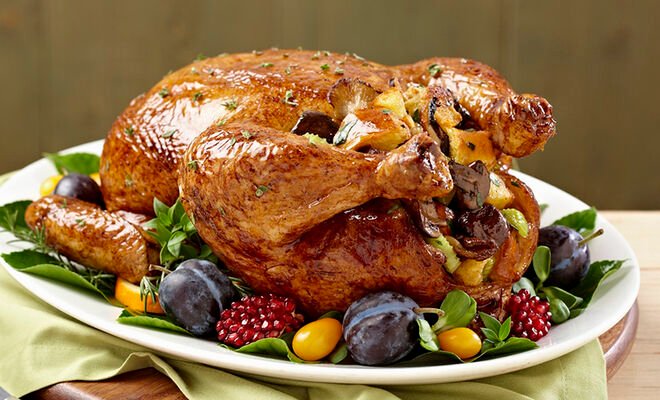#Thanksgiving #thanks #delicious #joyful
This year my turkey recipe is roasted in the French style rubbed in garlic and white wine, and served with a side of glazed chestnuts and buttery mushrooms.
Oven roasting is a straightforward method of cooking that surrounds uncovered food with indirect, dry heat. And with simple techniques*, it is easy to oven roast a succulent, golden brown turkey worthy of any feast, as follows:
Serves: 6 – 8
Ingredients
- 1 Organic, Heritage Wild Turkey, 8 to 10lbs
- 2 lemons, halved
- ½ cup softened French butter
- 3 cloves garlic, chopped
- Salt & freshly ground black Java pepper
- ½ teaspoon freshly ground nutmeg
- 1 cup dry white wine
- ¼ cup Avocado oil
- 2lbs cooked and peeled chestnuts
- 2 cups whole milk + more as needed
- 2 to 3 tablespoons pan drippings
- 1½ lbs Organic mixed large mushrooms, chopped
- 2 shallots, finely chopped
- 2 tablespoons flat leaf parsley, chopped
- 1 cup full-bodied red wine
- 2 cups turkey or chicken stock
- ½ cup crème fraiche
Preparation
- Bring the turkey to room temperature, then wipe inside and out with paper towels till dry. Rub the skin thoroughly with the cut lemons. For the marinade, mix the garlic, salt, pepper, and nutmeg in a bowl and whisk in the wine. Gradually whisk in the oil. With your hands, rub some the marinade over the inside and out of the turkey, reserving the rest. Truss the bird, cover, and let stand at room temperature for 30 mins. Heat the oven to 350 degrees F.
- Set the turkey in the roasting pan, spread it with the butter, and pour over the remaining marinade. Roast until the breast is brown, 25 to 30 mins. Baste well with the pan juices, cover loosely with aluminum foil, and continue roasting, basting often, for about 2 hrs longer. The turkey is done when the meat starts to pull from the leg bones, the juices run clear, not pink, when the thigh is pierced with a skewer, and a thermometer inserted in the thigh registers 165 degrees F. If the juices start to scorch during cooking, add 1 cup water to the pan and continue roasting.
- Meanwhile, peel the chestnuts and put them in a pan with enough milk to cover. Cover, bring to a boil, and simmer until the chestnuts are almost tender, 15 to 20 minutes. Do not let them get too soft or they will fall apart when roasted. Drain the chestnuts and put them in a baking dish. Add the drippings with salt and pepper and stir until the chestnuts are coated. Roast in the oven with the turkey until the chestnuts are glazed and very tender, 20 to 30 mins. Set them aside. The chestnuts may be cooked up to a day ahead and reheated before serving.
- For the mushrooms, clean them and cut into pieces if large. Melt 1 tablespoon of the butter in a frying pan over low heat. Add the mushrooms and salt and pepper, cover tightly, and cook gently until the juices run, 5 to 8 minutes. Remove the lid, raise the heat and continue cooking, stirring occasionally, until the liquid evaporates. Cooking time will vary from 5 to 10 mins, depending on the type of mushroom. Cream the remaining butter in a small bowl with the shallots, garlic, parsley, salt, and pepper and set it aside. The mushrooms and butter may be prepared ahead, ready to be reheated.
- When the turkey is cooked, transfer it to a platter, cover it loosely with aluminum foil, and keep it warm. For the gravy, pour or spoon off the fat from the roasting pan, leaving the pan juices. Add the wine to the roasting pan and simmer on the stove top, stirring to dissolve the juices, until reduced to 2 to 3 tablespoons glaze. Add the broth and continue simmering until reduced by half, 6 to 8 mins. Strain the gravy into a small saucepan, whisk in the crème fraîche, and bring just to a boil. Taste and adjust the seasoning.
- To finish, reheat the chestnuts and mushrooms on the stove top if necessary. Discard the trussing strings from the turkey and pile the chestnuts around it on the platter, ready to carve at the table. Stir the shallot butter into the mushrooms, taste, and adjust the seasoning. Pile the mushrooms in a warmed serving dish. Reheat the gravy, spoon a little over the turkey to moisten it, and serve the rest separately.
*The simplest technique is to borrow fat from a duck, rendered duck fat is just the ticket for this occasion. Just pat the turkey dry with a paper towel, and rub it all over with a generous coating of softened duck fat, before seasoning with the marinade. This fat will help the salt and pepper stay put and it will help the skin to brown. Not only is browned skin beautiful and tasty, it seals in natural juices during cooking. Roasting with duck fat will create crispy brown and delicately delicious skin, and,
Buttering beneath the skin is the 2nd technique, and this helps the bird to self-baste. For birds up to 16 lbs start with a well-chilled 1 lb roll of black truffle butter.
Use your fingers to slip between the skin and meat at the neck opening, gently working up to using your entire hand to ease your way carefully along the breast and leg meat, taking care not to puncture the skin.
If you have a Heritage bird then do this: Cloaking it with butter-soaked cotton cheesecloth is a technique that is especially good for a heritage turkey. Fold and trim a sheet of cheesecloth to create 4 layers large enough to drape and cling to the contours of the entire breast. It is okay to partially cover the drumsticks as well. Stack the 4 layers together and saturate in a basting mix of melted, unsalted butter and stock or dry white wine, and then drape the cloth over the bird. Brush the entire bird, including over the cloth, with the basting mix.
Once used only in professional kitchens, these products are widely available for home use at fine gourmet markets.
Have a joyful Thanksgiving holiday week, Keep the Faith!









